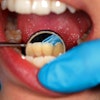Dear DrBicuspid member,
A new class of problem patients may seem jittery when you first meet them. They may wear sunglasses indoors or have burned fingertips. Or they may seem healthy and happy -- until they open their mouths to reveal the telltale pattern of crystal methamphetamine addiction. As we explain this week in our report on the growing problem of meth mouth, dentists must be prepared to recognize these symptoms, because meth addicts must be treated differently from other patients.
Such trends pose a growing challenge for dentists. So it's a pleasure to report that some aspects of dentistry are getting easier. In our report from last week's annual meeting of the American Academy of Cosmetic Dentistry, we focus on the benefits that soft-tissue lasers now offer for general dentists. The lasers make soft-tissue work easier because they can reduce bleeding and the need for anesthesia and sutures. This allows generalists to keep in-house some of the cases they used to refer to specialists. Find out more about soft-tissue lasers by clicking here.
But the more deeply you get into altering soft tissue, the more you must confront a fact many dentists overlook: our faces continue to change long after age 18. Discover the implications here.
What else happened in dentistry this week? The biggest news is that the FDA has approved the first-ever drug to reverse topical anesthesia. Click here to read more about the drug.
While you're exploring technological advances, you may also want to check out our tips for attracting patients to your Web site, and our advice on the latest cone-beam CT scanners in our Imaging Community. You can also get an advance look at imaging news in the future by subscribing to our Imaging Insider e-mail newsletter, which will start next month. To opt in, just click here.
Anything else you'd like to see covered? Just drop me a line.















